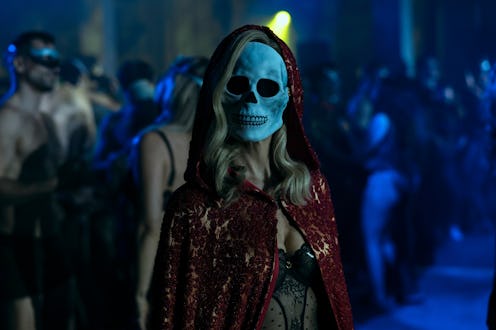TV & Movies
The Fall Of The House Of Usher Ending Is As Creepy As You Remember
A new Mike Flanagan series remixes some of Edgar Allan Poe’s most famous works.

While many people refer to the weeks leading up to Halloween as spooky season, if you’re a horror fan, it’s essentially Mike Flanagan season. Since 2018, the prolific creator has developed several of Netflix’s buzziest horror titles, including The Haunting of Hill House, The Haunting of Bly Manor, Midnight Mass, and The Midnight Club.
On Oct. 12, another limited series enters the chat: The Fall of the House of Usher. You might recognize the name from Edgar Allan Poe’s 1839 short story, but Flanagan’s adaptation delivers a “fresh, freaky twist,” according to Netflix. Other Poe stories will be referenced throughout the series as well.
“The entire catalog of Poe is wide open. It’s all public domain,” Flanagan said on The Boo Crew podcast in 2021, explaining how the show got to “cherry-pick” elements from the poet’s work to create a “blood-soaked and wild” story.
Here’s a quick rundown of the gothic tales that The Fall of the House of Usher pulls from.
The Fall Of The House Of Usher Book Summary & Ending, Explained
The Fall of the House of Usher follows an unnamed narrator as he travels to visit his childhood friend, Roderick Usher, who’s suffering from a mysterious illness. (It’s vague, even by 19th-century standards, but Roderick says it’s a “family sickness” that makes him very sensitive to his surroundings.)
Upon arriving at Roderick’s home, the titular House of Usher, the narrator feels afraid of the building’s decay. The disrepair reflects the dismal situation inside, too: Roderick reveals that his twin sister, Madeline, is also very sick.
Shortly after the narrator’s arrival, Madeline does die, and Roderick opts to keep her body in one of the home’s creepy vaults, worried that her unusual sickness would attract questions.
In the week after they bury Madeline, Roderick’s health deteriorates. The narrator finds himself growing exceedingly nervous. One stormy, sleepless night, the narrator tries to calm Roderick by reading him a book, but they’re interrupted by the house’s mysterious sounds.
It’s Madeline! She wasn’t dead, it seems. She manages to claw her way out of her tomb and rushes to her brother, who dies in fright. Madeline dies, too (for real this time).
Understandably, this is too much for the narrator. He runs away from the house and turns to see it crack into two and sink into the lake.
Other Poe Influences In The Fall Of The House Of Usher
Flanagan had plenty of leeway to expand Poe’s original story for the Netflix adaptation. For starters, in his version, the Usher family includes more than two living members. And the name of Roderick’s one true love, Annabel Lee, comes from the poem “Annabel Lee.” It was Poe’s final poem, which laments the death of a young partner.
Flanagan also borrowed other elements from the poet’s oeuvre to construct the eight-episode series. The trailer features a raven motif and the line “nevermore,” which both nod to Poe’s 1845 poem “The Raven.” And Carla Gugino plays a shape-shifter named Verna, whose name is an anagram of the bird.